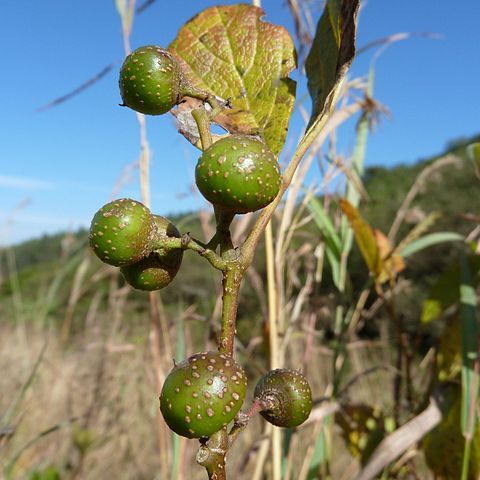Shrub, treelet or more often a woody climber 2–10 m. tall; young branches ferruginous pubescent, later glabrescent; sometimes with ‘potato-like’ roots (fide Tanner) presumably indicating it has tubers; tendrils fulvous pubescent or glabrescent.. Leaves 3-foliolate or rarely 1-foliolate due to fusion of 3 leaflets; leaflets narrowly to broadly obovate, the laterals somewhat asymmetric, 1.5–9(–16) cm. long, 0.7–5.5(–8) cm. wide, truncate to subacute at the apex, cuneate at the base, the laterals often rounded on one side, toothed towards the apex with (1–)3–18 teeth or rarely ± entire, glabrous to densely ferruginous pubescent; petiole 0.2–4 cm. long; petiolules up to 5(–12) mm. long; stipules ± 2 mm. long, tomentose, falling almost at once.. Cymes ± dense, the axes ferruginous pubescent or tomentose; peduncle 2–3 cm. long; pedicels ± 2 mm. long.. Calyx ± 1 mm. long, ferruginous tomentose.. Petals green, red or dark purplish, ± 2 mm. long, glabrous.. Fruit black, globose, 0.7–1.1 cm. in diameter, glabrous.. Seeds 1–4, greyish, ± globose or flattened on one side when paired, 5–6 mm. in diameter, somewhat rugose, with median longitudinal furrow.. Fig. 2.
It is a small neat tree. It grows to 3.6 m high. It can be a climber. It has a very extensive root system with a thickened rootstock or swellings along it. It may have many stems. The young branches are covered with rust-coloured hairs. It has tendrils. The leaves vary greatly in size and shape. They have 3 rigid leaflets. Leaves can be 10 cm long and 7 cm wide. The central leaflet is often triangular. The side leaflets are unequal-sided. Leaflets are glossy green above and paler underneath. The flowers are small and greenish. They occur in clusters opposite the leaves. The fruit is 1.3 cm across. They are smooth and round. They are black when mature. There are 1-2 seeds inside. The fruit is edible.
Leaves 3-foliolate; petiole 0·2–4 cm. long, pubescent or tomentose; stipules up to 2 mm. long, tomentose, very caducous; leaflet-lamina up to 9 × 5·5 cm., narrowly obovate to broadly obovate, apex truncate or more rarely subacute, base cuneate, lateral leaflets cuneate at the base or asymmetrically subcuneate to rounded on one side, margin dentate towards the apex, teeth from 3-c. 18 (in S. Africa forms occur with leaflets entire or with only 1–3 teeth), upper surface glabrous or fulvous-pubescent, lower surface from thinly fulvous-pubescent to densely fulvous-or rarely ferruginous-tomentose (forms with glabrous leaves occur in S. Africa); nerves prominent below; petiolules up to 5 mm. long.
Climber or shrub. Stems scandent or erect; ± 0.5-1.0 m or indefinite. Leaves petiolate or sessile; 3-foliolate; terminal leaflet sessile or with a petiolule, blade narrowly to broadly obovate, base cuneate, apex acute or truncate, lateral leaflets sessile or with short petiolules, apex acute, base asymmetrical, margins entire, toothed or crenate, glabrescent or grey-hairy. Flowers in leaf-opposed cymes or on tendrils. Petals yellowish green. Flowering time Nov.-Mar. Fruit subglobose, 8-10 mm in diam., red to purplish when ripe.
Shrub with branches scandent or erect, to 1 m. Leaves 3-foliolate, leaflets with margins ± entire or terminal leaflet 1-4-toothed or-crenate, glabrescent or grey-hairy. Flowers yellowish green. Fruits subglobose, red to purplish black.
Small shrub c. 2 m. tall sometimes with scandent branches or a tall climber up to 10 m. or more tall; young branches greyish-or fulvous-pubescent or occasionally ferruginous-tomentose; tendrils fulvous-pubescent or glabrescent.
Seeds 1–2, greyish, c. 6 mm. in diam., ± globose, flattened on one side if paired, somewhat rugose with one median longitudinal furrow.
Inflorescences of ± dense cymes; peduncle up to 2(3) cm. long, fulvous-tomentose or-pubescent; pedicels c. 2 mm. long.
Fruit black, up to 1 cm. in diam., globose, glabrous.
Corolla greenish, glabrous.
Calyx fulvous-tomentose.


